New Media is Rewiring Our Brains in Real-Time. What Does That Mean for Kids, Society, Civilization?
- Details
- Written by Sameer Ahuja
- Hits: 1220

Technology has become an integral and indisputably addictive aspect of our culture and society, particularly for teenagers and children. As President of the sports tech company GameChanger, Scarsdale resident Sameer Ahuja has much to say about kids and technology. GameChanger's mobile apps are used in all 50 states by millions of youth sports coaches, fans, and athletes to score, stream, and watched by over 6 million youth sports games a year. As a Trustee on the Scarsdale Village Board and a parent himself, Ahuja has some insights into the addictive nature of social media and its effects on children and teenagers.
He writes a newsletter, Consume at Once, that discusses how technology is transforming how we create and consume movies, videos, TV, games, sports, and social media. He recently wrote the following article: New Media is Rewiring our Brains in Real-Time. What Does That Mean for Kids, Society, Civilization which he shares below.
Anyone need a dopamine fix?
Having trouble concentrating? Easily bored? Distracted? Do you suffer from heightened anxiety? Memory issues? You may want to blame your smartphone. You know, that indispensable device we now look at 96 times a day.
While there are a lot of pluses about navigating life with a phone by your side—right now, you may be reading this very article on one—downsides abound. Significant ones. Recent research shows popular apps like Instagram and Reddit have been linked to a range of cognitive and emotional ills.
But that’s just the tip of the iceberg. If these researchers are correct, social media, video games, and other digital media are literally rewiring our brains.
How can skimming Twitter or playing Candy Crush change our brains? The answer is such applications leverage a biological phenomenon known as neuroplasticity. This concerns the brain’s ability to change its internal structure in reaction to new experiences.
Ever wonder why kids can learn language, play instruments, or grasp concepts far faster than adults? Young brains are especially plastic. As we age our plasticity wanes. We get stuck in our ways.
What’s more, the brain’s plasticity can be affected by physical trauma, drug use, or through powerful, persistent sensory stimulation. (Like playing VR games via a Meta Quest 2 headset for hours daily.)
The links between such digital usage and changes in cognitive function are real—and concerning. A 2014 study published in the journal PLOS ONE found people who frequently used social media had a thinner corpus callosum. This is the part of the brain that connects the left and right hemispheres.
The researchers suspect such a change may be due to the fragmented, less integrated way such media can be experienced. Other studies have shown that frequent social media use actually shrinks the part of the brain associated with concentration, leading to shorter attention spans.
But there’s another troubling mental health concern.
A growing number of psychologists now fear digital media may be impacting our social and emotional skills. A 2018 study published by Guilford Press Periodicals shows regular social media use can lead to feelings of isolation and depression. The researchers believe social media encourages social comparisons, producing emotions like inadequacy or insecurity.
Fortunately, they found limiting such exposure can produce positive outcomes. Our inherent plasticity allows us to bounce back. Even so, effects of social media, video games, and other digital media have been likened to those caused by addictive drugs and activities like gambling, both of which are known to literally rewire the brain. It all comes down to the neurotransmitter dopamine, a chemical that allows the brain to recognize pleasure.
Whatever the source of that pleasure—whether it’s a fine wine, sex, a funny cat video, or a recognizable reward—it causes part of the inner brain called the nucleus accumbens to release this powerful neurotransmitter. The chemical then reinforces those neural pathways associated with the activity that triggered its release. The faster and more frequent the dopamine release, the stronger these neural pathways become.
This is how addiction is achieved.
Certainly, everyone from neuroscientists to casino operators have long recognized the link between frequent (but unpredictable) rewards and addictive behavior. This is why most games of chance—particularly slot machines—offer small but frequent “wins” to players.
It keeps them hooked, unaware they’re actually losing.
The link between digital media and addiction is also no accident. From 20th century video games like Space Invaders and Pac-Man to 21st century social media platforms like TikTok, digital media creators have tapped into the brain’s natural plasticity by using sounds, rapidly changing images, and low-stakes “rewards” (e.g., “badges,” “gold coins,” “Likes,” “Shares,” etc.) to trigger dopamine release, reinforcing engagement behavior.
The more you play, the more you want to play.
For advertising-based platforms like Facebook, YouTube, Instagram, etc., attracting and, more importantly, keeping you engaged is key to their business model. Part of this is achieved through the low-stakes reward system of “Likes” and “Shares” described above.
But there’s another way to trigger dopamine release, and thus encourage addiction: creating outrage. As neurologists have discovered, anger triggers the primitive “fight or flight” response, which also happens to produce the release of dopamine.
And as social media algorithm designers have discovered, the angrier visitors become, the more likely they are to stay. Like rewards, outrage sells. Thus, once you click on a story or thread that angers you, the algorithm will feed you more of the same until it’s virtually all you consume.
As with any addiction, the first step in recovery from digital media overload is recognizing the problem. Now that we better understand how we may be being manipulated, we can more easily see the triggers, identify our own reactions, and work to overcome bad tendencies.
We can take back our minds.
Ironically, we can also use technology to help ward off tech addiction. Already, there are apps to help you track phone usage and warn you when you’ve reached a self-imposed daily limit. These platforms can also provide feedback on how much time you spend on various activities, helping you become more aware of your habits and able to make changes accordingly. Similarly, some apps even provide rewards or incentives if you successfully limit your screen time or reach specific goals, encouraging healthy habits.
There are also myriad mindfulness and meditation apps available, as well as mediation videos available free on YouTube. All this content can help you manage stress and anxiety, which can contribute to addictive behaviors, enabling you to better manage your emotions and develop a more self-conscious approach to technology usage.
Perhaps most powerful, is can technology be used to trigger the release of say oxytocin, known as the love hormone? Oxytocin is known to be associated with longer-term happiness. It can often be triggered by physical contact, listening to music, being in nature, getting exercise. Just because it hasn’t been done yet, does not mean it cannot. The global Silicon Valley specializes in disruption. Let’s disrupt dopamine!
Beyond using tech to retrain our minds, what’s also needed in the modern era is the cultivation of balance. One of the greatest minds of Western Culture himself, Aristotle championed equilibrium—way back in Antiquity. The profound Greek philosopher saw its cultivation to be a hallmark of a well-lived life.
He’s also known for saying in Metaphysics, “It is the mark of an educated mind to be able to entertain a thought without accepting it.”
 Sameer AhujaLearning from this example, might we consider a similar approach with the new media threatening to affect our cognition? Very much so. Just as mystics suggest being in this world—but not of this world—we can consciously decide to do something similar: Use our marvelous technologies competing for our attention—without allowing such usage to empower us.
Sameer AhujaLearning from this example, might we consider a similar approach with the new media threatening to affect our cognition? Very much so. Just as mystics suggest being in this world—but not of this world—we can consciously decide to do something similar: Use our marvelous technologies competing for our attention—without allowing such usage to empower us.
A tall order, I am aware.
But it’s vital we make such bold statements at the dawn of such an unprecedented time. The consequences could well be our ability to understand and interpret reality in our brave new world.
See more articles by Sameer Ahuja on his newsletter, Consume at Once.
Kids Continue to Find a Refuge in Dance
- Details
- Written by Joanne Wallenstein
- Hits: 1353
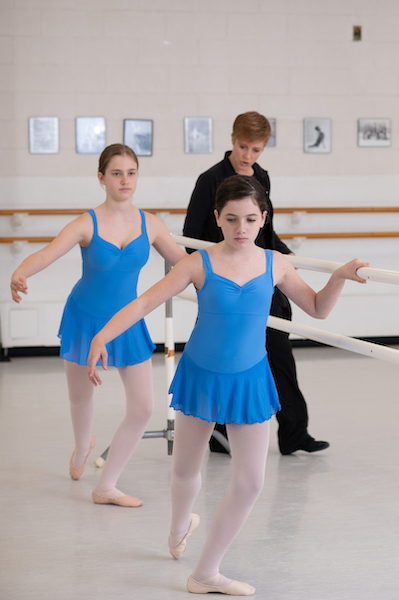 Here in Westchester and all throughout the country, parents have the ability to enroll their children in an endless variety of activities that bring physical, emotional and cognitive benefits. With so many choices, it can be challenging to narrow down the options they think might be the best fit and offer their children the best combination of enrichment and enjoyment.
Here in Westchester and all throughout the country, parents have the ability to enroll their children in an endless variety of activities that bring physical, emotional and cognitive benefits. With so many choices, it can be challenging to narrow down the options they think might be the best fit and offer their children the best combination of enrichment and enjoyment.
In honor of International Dance Day, I encourage all parents to explore the benefits of dance education and its renewed importance in today’s hyper digitally connected world.
International Dance Day is a global celebration of dance established through the United Nations Educational, Scientific and Cultural Organization (UNESCO). It occurs annually on April 29th, the anniversary of the birth of dance pioneer Jean-George Noverre.
Born in France in 1727, Noverre created the foundation of ballet as we know it today, but he never could have predicted the importance of his work among young people navigating 21st century realities.
When ballet students enter the studio here at the JCC Mid-Westchester in Scarsdale, they are greeted by not just their dance teacher, but also an accomplished pianist. This professional’s classical, acoustic accompaniment provides a soothing backdrop to the skillful, gentle, age-appropriate dance instruction, offering a refuge from the sensory overload that has invaded too many child-oriented spaces.
But even beyond ballet, all styles of dance have been shown to relieve stress, improve coordination and flexibility, and – impressively – enhance brain function. By teaching young people to focus on the details of movement, instructors help speed connections in their minds and improve their memorization skills. We’ve seen this first hand with our students enrolled in ballet, tap and hip hop, with parents sharing over and over again how they’ve seen a correlation with their children’s dance training and development.
In addition, children with special needs derive tremendous benefits from dance. For example, those with ADHD routinely experience improvements in their ability to focus. And those with behavioral challenges receive needed structure in the etiquette and rituals inherent in dance: its uniform, the set progression of class warm-ups, and required awareness of dancers’ personal space.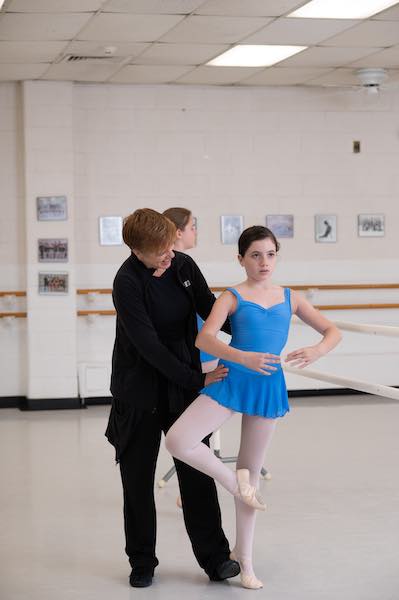
Of course, not all dance programs are the same. For example, many train students for today’s competitive dance circuit, adding a more potent team component as well as the concepts of winning and losing. The JCC Mid-Westchester dance school has intentionally avoided this particular track, instead focusing on the fundamentals of dance and its intrinsic motivations for self-improvement. We teach our students to take pride in their own personal dance accomplishments: the elevation of their jumps, the steadiness of their turns, their ability to connect with the music. And, of course, we want them to have fun!
As a long-time dance educator, nothing gives me a greater sense of pride than seeing my students grow and develop, both within and outside the studio. It drives me to continue advocating for traditional dance instruction as a powerful antidote to the stresses and pressures that, unfortunately, have come to define many children’s and adolescents’ experiences today.
Kristen McGrew is the dance director at the JCC Mid-Westchester in Scarsdale. She has served as a dance instructor since 1995. Previously, she danced with professional companies Eglevsky Ballet, Charleston Ballet Theater, Bravo Dance!, Tennessee Festival Ballet, and Ballet Theater of Pennsylvania; worked as a guest artist throughout the eastern United States; and performed across the country, dancing principal roles in the classics and world premieres.
(Sponsored content from JCCMW)
Music Festival Returns to Scarsdale on Saturday June 3, 2023
- Details
- Written by Joanne Wallenstein
- Hits: 1226
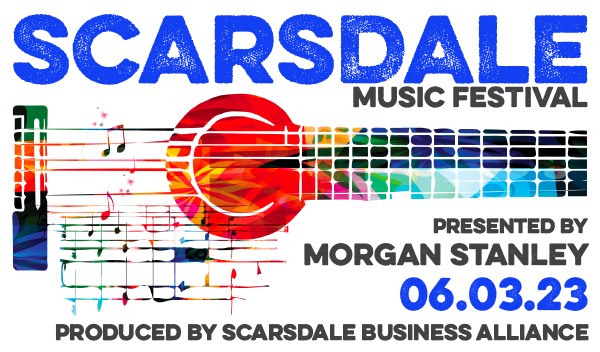 On Saturday, June 3, 2023, the Scarsdale Business Alliance (SBA) will host its 3rd Annual Scarsdale Music Festival (SMF), presented by Morgan Stanley. This year’s event will take place rain or shine in Scarsdale Village from 12-7pm and will benefit the Center for Cancer Care at White Plains Hospital.
On Saturday, June 3, 2023, the Scarsdale Business Alliance (SBA) will host its 3rd Annual Scarsdale Music Festival (SMF), presented by Morgan Stanley. This year’s event will take place rain or shine in Scarsdale Village from 12-7pm and will benefit the Center for Cancer Care at White Plains Hospital.
The SBA is thrilled to announce this year’s line-up of extraordinary talent who will be performing on two main stages throughout the day. Ten bands were chosen through an extensive selection process from over 50 submitted applicants from Scarsdale and the greater Tri-State Area.
● Alex Cano - Scarsdale-based artist with a debut album, “Every Rise of the Sun,” a story of resilience and survivorship and a raw slice of Rock n’ Roll.
● BOMBZR - An original, exciting, and groovin' supergroup on the rise in the NYC music scene, currently working on their debut album with three singles already released and streaming on all platforms.
● Conversing with Oceans - a fully evolved indie rock band based in Westchester looking to their rock past to explore new sounds and musical landscapes. Their debut LP “WILD / DREAMS” is a dedicated rock album at heart, displaying what these four musicians are capable of together.
● Gentlemen of Soul LSM - The top soul and R&B tribute band on the East Coast. A talented, dynamic 3-man vocal group from NYC, accompanied by a 4-piece band bringing Classic and Neo Soul, and R&B music to the stage.
● Rennie Pincus & Friends with Lovelight - Scarsdale-based band whose recent album, DEAL, explores the music of The Grateful Dead and features very special guests Elliot Easton (The Cars), Jack Petruzelli (Joan Osborne), Matt Rae (Arlen Roth), and Annalyse & Ryan.
● Rachel Bochner - Scarsdale native singer-songwriter turning the trials of navigating your twenties into pop music anyone can sing along to. With nearly 100,000 monthly listeners on Spotify and growing, Rachel has created a musical thumbprint that can only be recognized as her own.
● Skyfactor - NYC/Westchester-based band with members from Scarsdale. Their newest album is entitled "A Thousand Sounds," and they’re the band behind the song "OK" from MTV's hit show “Teen Mom.”
● The Del Bocas - A Scarsdale based-band, together for over ten years, see themselves as sort of a "wild jukebox" - with a large repertoire of songs from the 60’s to today.
● The Velcrows - Scarsdale-based band with 16 years together, putting their own spin on playing Rock & Roll, Rhythm & Blues, and some funky upbeat covers, which crowds will recognize.
We are also excited to welcome one of the winners of the 2023 NYS Music March Madness to our line-up. This annual music showdown competition has been shining a spotlight on talented artists and musicians from across the Empire State.
The Scarsdale Music Festival is an exceptional, family-friendly community event that will bring together people of all ages to celebrate their love of music, food, and community. The SBA is thankful to all the 2023 SMF event sponsors for their generous support.
● Presenting Sponsor: Morgan Stanley
● The Live Stages are presented by Advocate Brokerage Corp. with Pure, Houlihan Lawrence & Pepe Auto Group
● The Grand Tasting Zone is presented by Zachy’s & Julia B. Fee Sotheby’s International Realty
● The Family Fun Zone is presented by Scarsdale Moms
● Platinum sponsors: Compass, M.S. Walker, Spencer East Realty, The UPS Store
● Gold sponsors: Douglas Elliman, Scarsdale Security
● Silver Sponsors: Mark Jessamy Photography, NYS Music, Partyline Rentals, Rudy's Music, Westchester Magazine
The SMF is a free community event, with suggested donation tickets to benefit White Plains Hospital Center for Cancer Care. Tickets will go on sale in April. The SMF food vendor lineup and more details about this year’s expanded Family Fun Zone will be announced soon.
The Scarsdale Music Festival is a not-to-be missed experience! The SBA is a non-profit organization dedicated to supporting the Village of Scarsdale and its local businesses.
For event information and sponsorship opportunities:www.scarsdalemusicfestival.com
follow us on Instagram and Facebook @scarsdalemusicfestival.
For more information about the Scarsdale Business Alliance: www.scarsdalebusinessalliance.com and follow us on Instagram and Facebook @scarsdalebusiness.
Our Town: A Documentary About Greenacres On View, Online
- Details
- Written by Joanne Wallenstein
- Hits: 2028
 This fountain once bordered the Bronx River ParkwayIt’s been more than 100 years since ground was broken on the first homes in Greenacres and though much has changed, many signs of Scarsdale’s earliest residents remain. Strolling the streets you can find remnants of a gun powder factory across the street from Hitchcock Church, a stone wall that divided Scarsdale and White Plains on Farley Road and even earlier, a sign commemorating the Battle of White Plains in the Revolutionary War that took place on a hill on Mamaroneck Road.
This fountain once bordered the Bronx River ParkwayIt’s been more than 100 years since ground was broken on the first homes in Greenacres and though much has changed, many signs of Scarsdale’s earliest residents remain. Strolling the streets you can find remnants of a gun powder factory across the street from Hitchcock Church, a stone wall that divided Scarsdale and White Plains on Farley Road and even earlier, a sign commemorating the Battle of White Plains in the Revolutionary War that took place on a hill on Mamaroneck Road.
These landmarks and information about the original developers of the neighborhood are detailed in a rich documentary about the history of Greenacres, produced by the Scarsdale Historical Society. The film debuted at the Scarsdale Library on March 15 and is now available for all to see on the Scarsdale Historical Society’s website.
Originally a group of estates, Greenacres was built into a suburban community by developers and families who subdivided their land to create the neighborhoods we now enjoy. Many of the Tudor revivals and Colonial style homes that were constructed by the original builders are still treasured by residents today. The Bronx River Parkway was completed in 1924.
The Bronx River Parkway was completed in 1924.
Also at the time the neighborhood was built, Scarsdale Golf Club was constructed on what was formerly Harte’s Farm in 1922. Early members enjoyed golf, skeet shooting, ice skating and sledding.
The film details a beautiful fountain that once stood in front of a tea house on Fountain Terrace. That fountain remained until 1967 when the county widened the Bronx River Parkway and closed the park.
Perhaps the most enchanting story is one of a 1,380 foot tunnel that was built in 1939 to drain water from the field across from Walworth Avenue to Brite Avenue and down to the Bronx River. If anyone can find the entrance, let us know.
Watch the movie here – no matter what part of town you live in, you’re sure to be amazed at the history of our Village in a park.
 The 1,380 foot Greenacres Tunnel
The 1,380 foot Greenacres Tunnel
The Sporting Life in Scarsdale: Historic Photos on Display
- Details
- Written by Joanne Wallenstein
- Hits: 1242
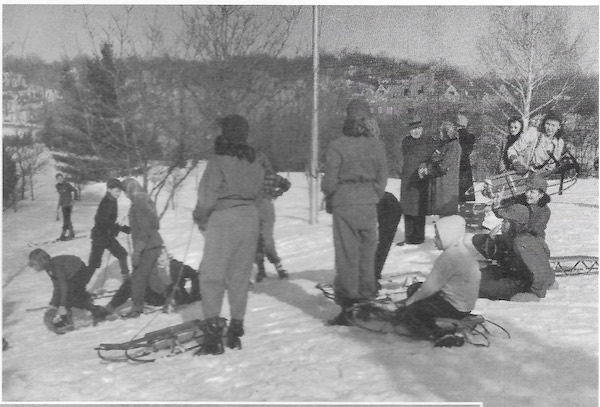 Sledding and skiing on the grounds of Scarsdale Golf Club, c. 1930’s. Credit: Scarsdale Golf ClubA new exhibit on display at Scarsdale Library, curated by the Scarsdale Historical Society, documents the development of winter sports in Scarsdale. Using photos from the Westchester County Archives, the Scarsdale Inquirer, Fox Meadow Tennis Club and Scarsdale Golf Club – (who celebrates its 125th anniversary this year), Leslie Chang brings to life the history of platform tennis, ice skating and coasting (sledding) by some of Scarsdale’s earliest residents.
Sledding and skiing on the grounds of Scarsdale Golf Club, c. 1930’s. Credit: Scarsdale Golf ClubA new exhibit on display at Scarsdale Library, curated by the Scarsdale Historical Society, documents the development of winter sports in Scarsdale. Using photos from the Westchester County Archives, the Scarsdale Inquirer, Fox Meadow Tennis Club and Scarsdale Golf Club – (who celebrates its 125th anniversary this year), Leslie Chang brings to life the history of platform tennis, ice skating and coasting (sledding) by some of Scarsdale’s earliest residents.
At a reception on Wednesday night March 1 to celebrate the opening of "Scarsdale On Ice," Chang told some captivating stories about the sporting life in Scarsdale.
The earliest reference to skating took place on “Scarsdale Lake,” which was formed when a dam was built in the Bronx River in 1913 that created a lake, just above the current waterfall near Scarsdale Village. Skaters also used the Duck Pond and Greenacres Pond, along with pop-up rinks created by flooding sections of Crossway Field, Hyatt Field and the Brite Avenue Tennis Courts.
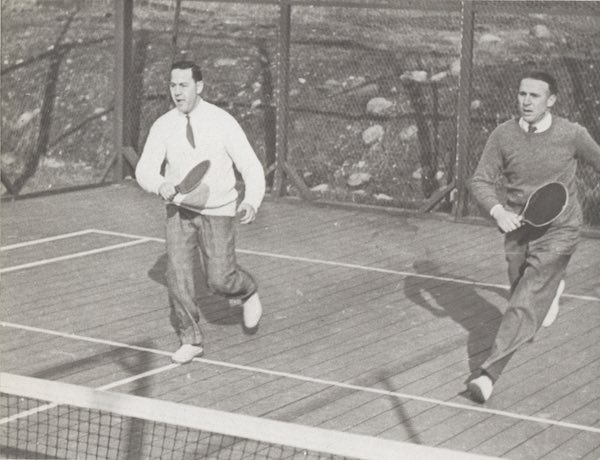 Charlie O'Hearn and Jim Hynson play platform tennis at FMTC in 1938. Credit: Fox Meadow Tennis ClubIn 1952 the Recreation Department hosted a pop-up rink by flooding a 75 X 100 foot section of the Brewster Road parking lot at Scarsdale High School. During the holiday break, a reported 3,200 skaters turned out to enjoy the rink, floodlights and music. In 1973 a $500,000 bond proposal was made to build a skating rink the size of Rye Playland near the Scarsdale Pool, but it failed to get sufficient votes.
Charlie O'Hearn and Jim Hynson play platform tennis at FMTC in 1938. Credit: Fox Meadow Tennis ClubIn 1952 the Recreation Department hosted a pop-up rink by flooding a 75 X 100 foot section of the Brewster Road parking lot at Scarsdale High School. During the holiday break, a reported 3,200 skaters turned out to enjoy the rink, floodlights and music. In 1973 a $500,000 bond proposal was made to build a skating rink the size of Rye Playland near the Scarsdale Pool, but it failed to get sufficient votes.
 Joslyn and Sally Magowan trap shooting at the Scarsdale Golf Club in 1928. The sport was once popular during the club's off season. Credit: Magowan - Birdzell FamilyIn the 1920's two skilled ice dancers, James Cogswell and Fessendon Blanchard, taught others at Fox Meadow Tennis Club where the courts were flooded to form a rink. Skaters danced to the accompaniment of Viennese Waltzes and German Polkas that were amplified over the courts. But these two are even more famous for developing the sport of Platform Tennis. In 1928 they built the first court at their home above Ardsley Road and tested different racquets and balls. After losing too many balls that flew down Ardsley Road, they built a chicken wire fence around the court. Eventually they convinced Fox Meadow Tennis Club to build their first platform tennis court in 1931 and the club found that it improved their membership numbers during the winter months. The rest is history!
Joslyn and Sally Magowan trap shooting at the Scarsdale Golf Club in 1928. The sport was once popular during the club's off season. Credit: Magowan - Birdzell FamilyIn the 1920's two skilled ice dancers, James Cogswell and Fessendon Blanchard, taught others at Fox Meadow Tennis Club where the courts were flooded to form a rink. Skaters danced to the accompaniment of Viennese Waltzes and German Polkas that were amplified over the courts. But these two are even more famous for developing the sport of Platform Tennis. In 1928 they built the first court at their home above Ardsley Road and tested different racquets and balls. After losing too many balls that flew down Ardsley Road, they built a chicken wire fence around the court. Eventually they convinced Fox Meadow Tennis Club to build their first platform tennis court in 1931 and the club found that it improved their membership numbers during the winter months. The rest is history!
The Scarsdale Historical Society has produced an engaging exhibit of posters featuring historic photos and stories about winter sports in Scarsdale that is on view to the public at Scarsdale Library. Check out "Scarsdale on Ice," to fully understand how our forbearers left behind the legacy of the sporting life that continues today.
 The Board of the Scarsdale HIstorical Society at the opening of "Scarsdale on Ice."
The Board of the Scarsdale HIstorical Society at the opening of "Scarsdale on Ice."














